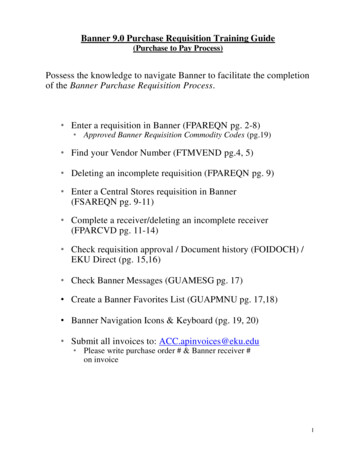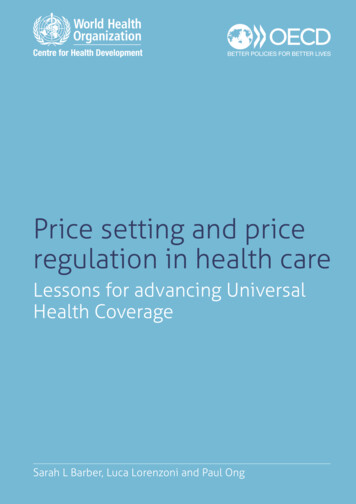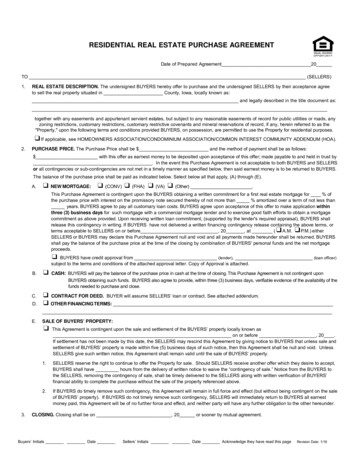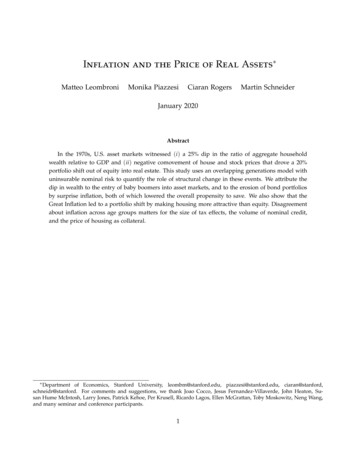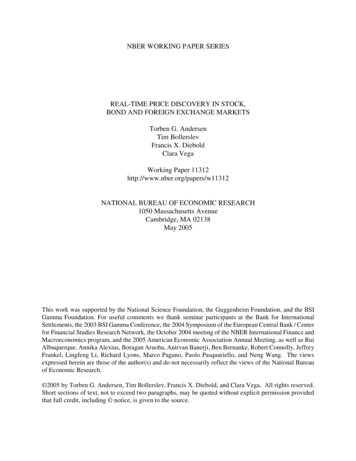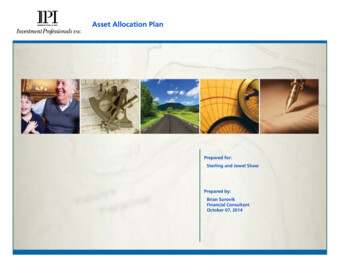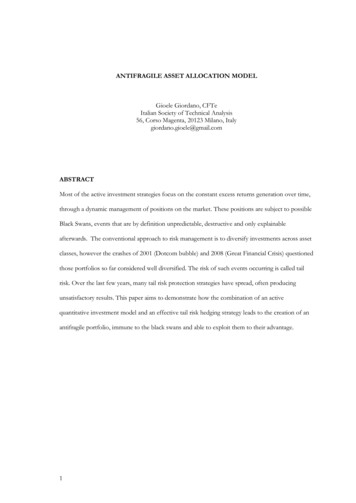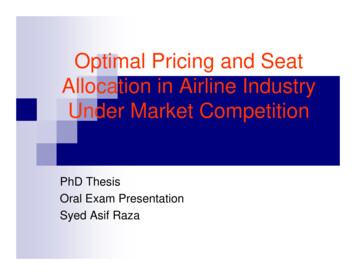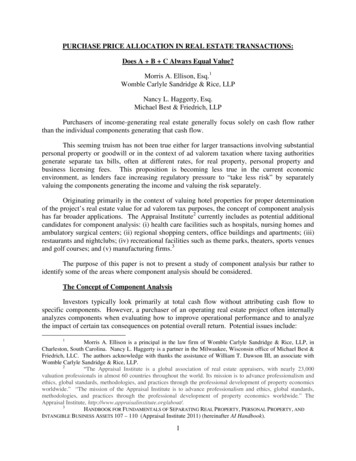
Transcription
PURCHASE PRICE ALLOCATION IN REAL ESTATE TRANSACTIONS:Does A B C Always Equal Value?Morris A. Ellison, Esq.1Womble Carlyle Sandridge & Rice, LLPNancy L. Haggerty, Esq.Michael Best & Friedrich, LLPPurchasers of income-generating real estate generally focus solely on cash flow ratherthan the individual components generating that cash flow.This seeming truism has not been true either for larger transactions involving substantialpersonal property or goodwill or in the context of ad valorem taxation where taxing authoritiesgenerate separate tax bills, often at different rates, for real property, personal property andbusiness licensing fees. This proposition is becoming less true in the current economicenvironment, as lenders face increasing regulatory pressure to “take less risk” by separatelyvaluing the components generating the income and valuing the risk separately.Originating primarily in the context of valuing hotel properties for proper determinationof the project’s real estate value for ad valorem tax purposes, the concept of component analysishas far broader applications. The Appraisal Institute2 currently includes as potential additionalcandidates for component analysis: (i) health care facilities such as hospitals, nursing homes andambulatory surgical centers; (ii) regional shopping centers, office buildings and apartments; (iii)restaurants and nightclubs; (iv) recreational facilities such as theme parks, theaters, sports venuesand golf courses; and (v) manufacturing firms.3The purpose of this paper is not to present a study of component analysis bur rather toidentify some of the areas where component analysis should be considered.The Concept of Component AnalysisInvestors typically look primarily at total cash flow without attributing cash flow tospecific components. However, a purchaser of an operating real estate project often internallyanalyzes components when evaluating how to improve operational performance and to analyzethe impact of certain tax consequences on potential overall return. Potential issues include:1Morris A. Ellison is a principal in the law firm of Womble Carlyle Sandridge & Rice, LLP, inCharleston, South Carolina. Nancy L. Haggerty is a partner in the Milwaukee, Wisconsin office of Michael Best &Friedrich, LLC. The authors acknowledge with thanks the assistance of William T. Dawson III, an associate withWomble Carlyle Sandridge & Rice, LLP.2“The Appraisal Institute is a global association of real estate appraisers, with nearly 23,000valuation professionals in almost 60 countries throughout the world. Its mission is to advance professionalism andethics, global standards, methodologies, and practices through the professional development of property economicsworldwide.” “The mission of the Appraisal Institute is to advance professionalism and ethics, global standards,methodologies, and practices through the professional development of property economics worldwide.” TheAppraisal Institute, http://www.appraisalinstitute.org/about/.3HANDBOOK FOR FUNDAMENTALS OF SEPARATING REAL PROPERTY, PERSONAL PROPERTY, ANDINTANGIBLE BUSINESS ASSETS 107 – 110 (Appraisal Institute 2011) (hereinafter AI Handbook).1
Real estate transfer taxes;4 Allocation of basis for income tax purposes; Real and personal property tax assessments and taxes; and Segregation of readily depreciable/amortizable assets fromnondepreciable/amortizable assets.5Value allocation generally involves four components:1. Land (non-depreciable);2. Buildings/improvements (generally depreciable over lengthy time periods);3. Tangible personal property; and4. Goodwill/ongoing business value represented by intangible personal property or“business enterprise value.”The terminology surrounding this fourth component is confusing and referred to bymultiple names including intangible value, goodwill and business enterprise value (“BEV”).6The Dictionary of Real Estate Appraisal defines “business enterprise value” as “the valuecontribution of the total intangible assets of a continuing business enterprise such as marketingand management skill, an assembled work force, working capital, trade names, franchises,patents, trademarks, contracts, leases, and operating agreements.”7 The Appraisal of Real Estatedoes not specifically define BEV but offers the following comments on the value of a goingconcern:A going concern is an established and operating business with an indefinitefuture life. For certain types of properties (e.g., hotels and motels, restaurants,bowling alleys, manufacturing enterprises, athletic clubs, landfills), the physicalreal estate assets are integral parts of an ongoing business. The market value ofsuch a property (including all the tangible and intangible assets of the goingconcern, as if sold in aggregate) is commonly referred to by laymen as businessvalue or business enterprise value, but in reality it is market value of the goingconcern including real property, personal property, and the intangible assets of thebusiness.84The applicability of transfer taxes is jurisdiction specific but the taxes are usually based on the“value” of the real estate being sold. See, e.g., S.C. CODE ANN. § 12-24-10 et seq. (2000 & Supp. 2011). Includingthe overall value of the business within the stated consideration on a deed will generally lead to unnecessarily highertransfer taxes.5See Michael Allen, Price Allocation, Gain Tax Benefits by Allocating Price Before Closing Sale ofBusiness, PRACTICAL TAX STRATEGIES, Aug. 25, 2008.6See AI Handbook, p. 101-107.7APPRAISAL INSTITUTE, DICTIONARY OF REAL ESTATE APPRAISAL 25 (5th ed. 2010).8APPRAISAL INSTITUTE, APPRAISAL OF REAL ESTATE 29 (13th ed. 2008).2
Integrating a well thought out allocation into a purchase transaction can yield significantincome, property and transfer tax savings and simplify recordkeeping. In fact, in manytransactions, a component analysis is critical, if not required. For example, price allocation canbe worth tens of millions of dollars currently and in future depreciation in addition to transfer taxand ad valorem property tax considerations.When analyzing the value of income producing real estate properties, the AppraisalInstitute, Internal Revenue Service (“IRS”), Securities Exchange Commission (“SEC”) andFinancial Accounting Standards Board pronouncements of the America Institute of CertifiedPublic Accountants (“FASB”) all recognize that a property’s value includes an intangible valuecomponent9. Similarly, component analysis is applied in ad valorem taxation where taxingauthorities are generally charged with separately taxing (i) real property value, (ii) personalproperty value, and (iii) intangible value, often at different rates.10 For example, somejurisdictions do not tax personal property.11While the concept of BEV may be generally recognized, no consensus exists as to how toextract this intangible value from the property’s overall value. That lack of consensus may helpexplain some of the vitriol surrounding the debate in the appraisal world on how to calculateBEV. Some also suggest that the concept raises questions as to the qualifications of real estateappraisers to value at least some of the components creating value, suggesting that this role isbetter suited for business valuation experts. Although particular circumstances may call for acomponent analysis for a going concern (e.g., such as to apply those components to specificstatutory definitions of taxable value), using a component analysis for appraisal purposes,particularly for a loan appraisal, imposes artificial boundaries on value and creates substantialrisk to lenders if they fail to secure the components of a project generating important sources ofincome, simply because they cannot be easily defined.Definition of “Highest and Best Use”Any analysis of a property’s value begins with a determination of the property’s highestand best use. The 2010 edition of the Appraisal Institute’s Dictionary of Real Estate alters thedefinition of “highest and best use.” The 2010 edition defines “highest and best use” as:“the reasonably probable and legal use of vacant land or an improved property that isphysically possible, appropriately supported, financially feasible, and that results in thehighest value. The four criteria the highest and best use must meet are legalpermissibility, physical possibility, financial feasibility, and maximum productivity.Alternatively, the probable use of land or improved property-specific with respect to theuser and timing of the use-that is adequately supported and results in the highest presentvalue.”129See, e.g., 2012 Internal Revenue Service Manual, Part 4, Chapter 48, Section 5; FASB AccountingStandards Codification ¶ 350-20-35-3 and 3A-3G.10See, e.g., S.C. CODE ANN. §§ 12-37-220; 12-37-930 (2000 & Supp. 2011).11Ohio phased out the tax on tangible personal property. See OHIO REV. CODE ANN. § 5711.22(2005).12APPRAISAL INSTITUTE, DICTIONARY OF REAL ESTATE APPRAISAL 93 (5th ed. 2010).3
The difference stems from the new definition’s focus on “highest present value” whichimplies the need to consider the cost and risk associated with achieving a certain prospective use.Previously, the Appraisal Institute defined “highest and best use” as “the reasonable, probableand legal use of vacant land or improved property, which is physically possible, appropriatelysupported, financially feasible, and that results in the highest value.”13 The difference is subtle,but potentially significant.Three Approaches to ValueReal property appraisals recognize three basic approaches to value. In estimating aproperty’s value, all factors affecting market value or would influence the purchaser’s mindshould be considered, such as location, quality, condition and use.14 The three basic approachesare:(i)Replacement cost approach;(ii)Sales comparable approach; and(iii)Income approach.15The concept of component analysis applies only to the income approach.Cost ApproachThe cost approach values property based on the amount of money required, using currentmaterial and labor costs, to replace the property with similar property. The usefulness of the costapproach is limited to special-purpose properties and properties not frequently exchanged in themarket and is questionable when valuing older property.16Sales Comparison ApproachThe sales comparison approach involves the examination of sales of similar propertiesand comparing the values realized in these sales. Put simply, this approach compares the valueof all property in the same area/neighborhood to other properties with special emphasis on theprices of properties that have recently sold.13APPRAISAL INSTITUTE, THE APPRAISAL OF REAL ESTATE 277-278 (13th ed. 2008).See 84 C.J.S. Taxation § 511 (2001).15In jurisdictions where the tax assessor is charged with equalizing value during periodicreassessments, there is a fourth approach which is not recognized by the Appraisal Institute. This approach is oftencalled the “equity value” approach. In broad strokes, the “equity value” approach compares tax assessments ofsimilar properties rather than the fair market value of similar properties. See, e.g., Meeting Street Ventures, LLC v.Charleston County Assessor, 2004 WL 3154642, Docket No. 03-ALJ-17-0297-CC (S.C.Admin.Law.Judge.Div.Feb. 19, 2004). The income approach is the approach most frequently relied upon in valuing hotels for ad valoremreal property tax purposes.16See APPRAISAL INSTITUTE, THE APPRAISAL OF REAL ESTATE 377-384 (13th ed. 2008).144
Proper application of the sales comparison approach requires an investigation into allpertinent information that influenced the reported sales prices to be used for comparisonpurposes. For example, bulk sales or Section 1031 exchanges of property need to be analyzed,and sometimes discounted, to determine what a willing purchaser paid a willing seller for theparticular property regardless of other considerations. Correct application of the salescomparison approach is an essential part of the valuation process, as it provides a probable rangeof market value for the subject property. In the sales comparison approach, the geographic limitsof the appraiser’s search for sales data depend on the nature and type of real estate being valued.To determine a fair market value for property, a comparison of the sales price forproperties with similar characteristics may be utilized. While not conclusive, the sales price forcomparable properties presents probative evidence of the fair market value of the property atissue.17 Although many assessors often make a blanket assertion that the sales comparisonapproach is the most reliable way of determining value of residential property, the market for theproperty must nevertheless be defined. This concept is particularly true for commercialproperties such as hotels and regional malls, among others, which are often considered to haveregional or national markets.Untrained appraisers often fail to analyze the data underlying reported sales to determinewhether the sales are in fact comparable. Mistakes associated with the sales comparisonapproach include using bulk sales of properties or properties involved in Section 1031 exchangeswhere tax and other considerations often influence the stated consideration for a particularproperty. These types of sales fail to demonstrate what a willing buyer would pay a willingseller for the property looking at the individual property since other considerations may havebeen paramount. This statement is particularly true in the current real estate market where a realline of demarcation can be shown to exist after the 2008 collapse of the credit markets. Use ofpre-crash data is problematic and requires a careful eye.Many statutory taxing schemes assume a fictional sale has taken place on the valuationdate. In the tax appeal world, nearly all jurisdictions use a similar definition of “value” for advalorem tax purposes. Under South Carolina law, real property must be valued as follows:18All property must be valued for taxation at its true value in money which in allcases is the price which the property would bring following reasonable exposureto the market, where both the seller and buyer are willing, are not acting undercompulsion, and are reasonably well informed of the uses and purposes for whichit is adapted and for which it is capable of being used.19This statutory scheme does not recognize or consider the impact of a complete collapse ofcredit markets in late 2008 and early 2009. Many properties changing hands since September17See Sea Pines Plantation Co. v. Beaufort County, 2002 WL 148696, at *6 Docket No. 01-ALJ-170018-CC (S.C.Admin.Law.Judge.Div. June 20, 2002); South Carolina Nat’l Bank (Wachovia Bank of SouthCarolina) v. Anderson County Assessor, 1996 WL 909127, Docket No. 95-ALJ-17-0271-CC(S.C.Admin.Law.Judge.Div. Feb. 13, 1996).18See, e.g., S. C. CODE ANN. § 12-37-3140 (2000 & Supp. 2011), which assumes a fictional sale asof December 31 of the year prior to the assessment.19S. C. CODE ANN. § 12-37-930 (2000 & Supp. 2011).5
2008 have not involved willing sellers and willing buyers due primarily to difficulties withexisting or available financing. Other reported sales are distressed sales and the use of thesesales is problematic, at best, in calculating value.The impact of the effect of the financial crisis on sales cannot be overstated as the recentfinancial crisis rendered transparent the definition of “market value.” Appraisal methodology isfounded on the concept that, at any given point in time, a “market value” can be clearlydiscerned in comparison to recent comparable sales. However, the sale comparison method, bydefinition, is retrospective, and considers stale information, which, for better or worse, may notreflect actual current value. Despite the availability of public information on recent sales inpublic and proprietary databases, many of the facts about these transactions are silent, and can beeasily flawed by non-reported terms such as purchaser’s deadline to name a replacementproperty for a Section 1031 exchange, that substantial personal property was included in the sale,or that the sale was a redemption just prior to a threatened foreclosure. Given the difficultieswith conventional bank financing for real estate purchases in the past few years, appraisersdiscovered no sales in thinly traded markets, or, upon investigation, that every sale was in someway a distressed sale. A recent bulk sale of a comparable property by a distressed seller cansignificantly impact the market value of comparable properties, especially on lots orcondominium units in the same distressed project, so that every succeeding sale has a loweredvalue based on the reduced sale price of the prior sale, in a race to the bottom. Every succeedingnon-distressed sale is encumbered by comparable values taken from distressed sales.Income Approach:The income approach to real estate value converts the anticipated future benefits ofproperty ownership into an estimate of present value20 and requires:i.a calculation of the net income being generated for a property before debtservice; andii.a determination of a capitalization rate for such net income.Net income is divided by a capitalization rate to determine the property’s appropriatevalue. If there are errors with either (i) the capitalization rate; or (ii) the calculation of the netincome being generated by a property, the calculated value of a property using the incomeapproach will be flawed. In the ad valorem tax world where the assessor is charged with valuingreal estate (as opposed to personal property or “business value”), net operating income is theactual or anticipated net income of the real estate (as opposed to the business) remaining after thededuction of operating expenses but prior to deducting mortgage debt service and bookdepreciation.21 Another problem facing appraisers as markets struggle to exit the 2008 economicdownturn is that many valuation professionals are being asked to value properties with negativeincome for the year preceding the valuation date.20See Stephen Rushmore & Erich Baum, Hotels & Motels: Valuations and Market Studies 318(Appraisal Inst. 2001).21APPRAISAL INSTITUTE, THE APPRAISAL OF REAL ESTATE 457 (13th ed. 2010).6
Component analysis applies to the income approach. As noted above, taxing authoritiesin most jurisdictions are charged with separately taxing a property’s components for purposes ofseparately assessing taxes on real property and personal property. However, many properties,such as hotels and nursing homes, operate as businesses, not as individual components. Forexample, a nursing home cannot generally operate without licenses, some of which are generallynot transferable. The same general statement holds true for hotels. For more than two decades,the appraisal industry has recognized the unique challenges posed by hotels in determining netincome of a hotel for real estate tax purposes. The argument in the appraisal world regarding theproper methodology for extracting real estate value is quite heated and will be discussed below.There is an inherent tension between an owner seeking an appraisal to lower ad valoremtax bill by attributing income to non-real estate components and an appraisal sought for loan orsale purposes. .If a component analysis does not perfectly fit for ad valorem purposes (meaningsome intangible components of the operation are not valued and therefore not taxed), the owneris not likely to be troubled, because ad valorem taxes, by statutory definition, only apply tocertain distinct components of the enterprise. However, if this same methodology is used forpurposes of appraisals for financing and sales, the owner will not be forgiving if substantialportions of the income are overlooked simply because they cannot be separately valued. In otherwords, owners seeking a real estate appraisal for real estate loan purposes generally maximizethe “real estate” project’s in
Oct 15, 2019 · 2 “The Appraisal Institute is a global association of real estate appraisers, with nearly 23,000 valuation professionals in almost 60 countries throughout the world. Its mission is to advance professionalism and ethics, global standards, methodologies, and practices t
